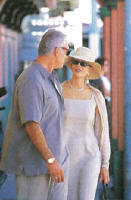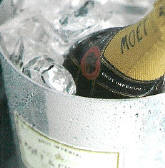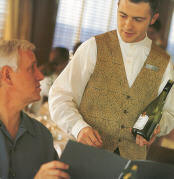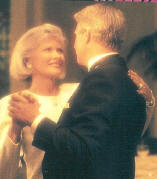|
Awaiting Your Return From Shore |
 For centuries, the cliff-top site of what is now
Québec City was occupied by a native Iroquois village. The first permanent
European settlement began in 1608 when Samuel de Champlain established a fur
trading post. By 1663, New France had become a royal province, administered
by a council appointed directly by the crown and answerable to the king’s
council in France. Long-brewing European struggles between England and
France spilled over into the colonies, prompting the construction of
Québec’s formidable fortifications. The Seven Years War put an end to French
reign and left the city in English hands. An American attack in 1775 was
successfully warded off by the English, and for the next century Québec
quietly earned its livelihood as a center for shipbuilding and timber trade.By 1840, when it was declared the provincial capital of Lower Canada, the
accessible supplies of timber had run out. The final blow came with the
appearance of steamships that could travel as far as Montréal, while sailing
ships found it difficult to proceed beyond Québec City. Losing its
importance as a major port, the city experienced a decline but remained as a
center of small industry and local government. Later years saw a tremendous rise as tourism made use of Québec’s fantastic
location and appearance. Being Canada’s most historic city and the only walled city in North America
earned it the classification of World Heritage Treasure by UNESCO in 1985.
Today, the visitor is greeted by an authentic, profoundly French city, where
95% of its half million people are French-speaking. Both parts of the city
Haute-Ville and Basse-Ville (Upper and Lower Town) feature winding,
cobbled streets flanked by 17th- and 18th-century stone houses and churches,
graceful parks and squares and countless monuments. Croissants and steaming
cups of coffee at a sidewalk café conjure images, aromas and sounds of
Paris.Great emphasis has been placed on Québec nationalism; as a result the city
has become a symbol of the glory of French heritage. The motto "Je me
souviens" (I remember) is inscribed above the entrance to the Parliament
Building and on the license plates of Québec cars. As you come ashore,
endless pleasures await you in this marvelous city. For centuries, the cliff-top site of what is now
Québec City was occupied by a native Iroquois village. The first permanent
European settlement began in 1608 when Samuel de Champlain established a fur
trading post. By 1663, New France had become a royal province, administered
by a council appointed directly by the crown and answerable to the king’s
council in France. Long-brewing European struggles between England and
France spilled over into the colonies, prompting the construction of
Québec’s formidable fortifications. The Seven Years War put an end to French
reign and left the city in English hands. An American attack in 1775 was
successfully warded off by the English, and for the next century Québec
quietly earned its livelihood as a center for shipbuilding and timber trade.By 1840, when it was declared the provincial capital of Lower Canada, the
accessible supplies of timber had run out. The final blow came with the
appearance of steamships that could travel as far as Montréal, while sailing
ships found it difficult to proceed beyond Québec City. Losing its
importance as a major port, the city experienced a decline but remained as a
center of small industry and local government. Later years saw a tremendous rise as tourism made use of Québec’s fantastic
location and appearance. Being Canada’s most historic city and the only walled city in North America
earned it the classification of World Heritage Treasure by UNESCO in 1985.
Today, the visitor is greeted by an authentic, profoundly French city, where
95% of its half million people are French-speaking. Both parts of the city
Haute-Ville and Basse-Ville (Upper and Lower Town) feature winding,
cobbled streets flanked by 17th- and 18th-century stone houses and churches,
graceful parks and squares and countless monuments. Croissants and steaming
cups of coffee at a sidewalk café conjure images, aromas and sounds of
Paris.Great emphasis has been placed on Québec nationalism; as a result the city
has become a symbol of the glory of French heritage. The motto "Je me
souviens" (I remember) is inscribed above the entrance to the Parliament
Building and on the license plates of Québec cars. As you come ashore,
endless pleasures await you in this marvelous city.
|
Awaiting Your Return
From Shore |




 For centuries, the cliff-top site of what is now
Québec City was occupied by a native Iroquois village. The first permanent
European settlement began in 1608 when Samuel de Champlain established a fur
trading post. By 1663, New France had become a royal province, administered
by a council appointed directly by the crown and answerable to the king’s
council in France. Long-brewing European struggles between England and
France spilled over into the colonies, prompting the construction of
Québec’s formidable fortifications. The Seven Years War put an end to French
reign and left the city in English hands. An American attack in 1775 was
successfully warded off by the English, and for the next century Québec
quietly earned its livelihood as a center for shipbuilding and timber trade.By 1840, when it was declared the provincial capital of Lower Canada, the
accessible supplies of timber had run out. The final blow came with the
appearance of steamships that could travel as far as Montréal, while sailing
ships found it difficult to proceed beyond Québec City. Losing its
importance as a major port, the city experienced a decline but remained as a
center of small industry and local government. Later years saw a tremendous rise as tourism made use of Québec’s fantastic
location and appearance. Being Canada’s most historic city and the only walled city in North America
earned it the classification of World Heritage Treasure by UNESCO in 1985.
Today, the visitor is greeted by an authentic, profoundly French city, where
95% of its half million people are French-speaking. Both parts of the city
Haute-Ville and Basse-Ville (Upper and Lower Town) feature winding,
cobbled streets flanked by 17th- and 18th-century stone houses and churches,
graceful parks and squares and countless monuments. Croissants and steaming
cups of coffee at a sidewalk café conjure images, aromas and sounds of
Paris.Great emphasis has been placed on Québec nationalism; as a result the city
has become a symbol of the glory of French heritage. The motto "Je me
souviens" (I remember) is inscribed above the entrance to the Parliament
Building and on the license plates of Québec cars. As you come ashore,
endless pleasures await you in this marvelous city.
For centuries, the cliff-top site of what is now
Québec City was occupied by a native Iroquois village. The first permanent
European settlement began in 1608 when Samuel de Champlain established a fur
trading post. By 1663, New France had become a royal province, administered
by a council appointed directly by the crown and answerable to the king’s
council in France. Long-brewing European struggles between England and
France spilled over into the colonies, prompting the construction of
Québec’s formidable fortifications. The Seven Years War put an end to French
reign and left the city in English hands. An American attack in 1775 was
successfully warded off by the English, and for the next century Québec
quietly earned its livelihood as a center for shipbuilding and timber trade.By 1840, when it was declared the provincial capital of Lower Canada, the
accessible supplies of timber had run out. The final blow came with the
appearance of steamships that could travel as far as Montréal, while sailing
ships found it difficult to proceed beyond Québec City. Losing its
importance as a major port, the city experienced a decline but remained as a
center of small industry and local government. Later years saw a tremendous rise as tourism made use of Québec’s fantastic
location and appearance. Being Canada’s most historic city and the only walled city in North America
earned it the classification of World Heritage Treasure by UNESCO in 1985.
Today, the visitor is greeted by an authentic, profoundly French city, where
95% of its half million people are French-speaking. Both parts of the city
Haute-Ville and Basse-Ville (Upper and Lower Town) feature winding,
cobbled streets flanked by 17th- and 18th-century stone houses and churches,
graceful parks and squares and countless monuments. Croissants and steaming
cups of coffee at a sidewalk café conjure images, aromas and sounds of
Paris.Great emphasis has been placed on Québec nationalism; as a result the city
has become a symbol of the glory of French heritage. The motto "Je me
souviens" (I remember) is inscribed above the entrance to the Parliament
Building and on the license plates of Québec cars. As you come ashore,
endless pleasures await you in this marvelous city.
 Elegant DiningTop Entertainment
Elegant DiningTop Entertainment

